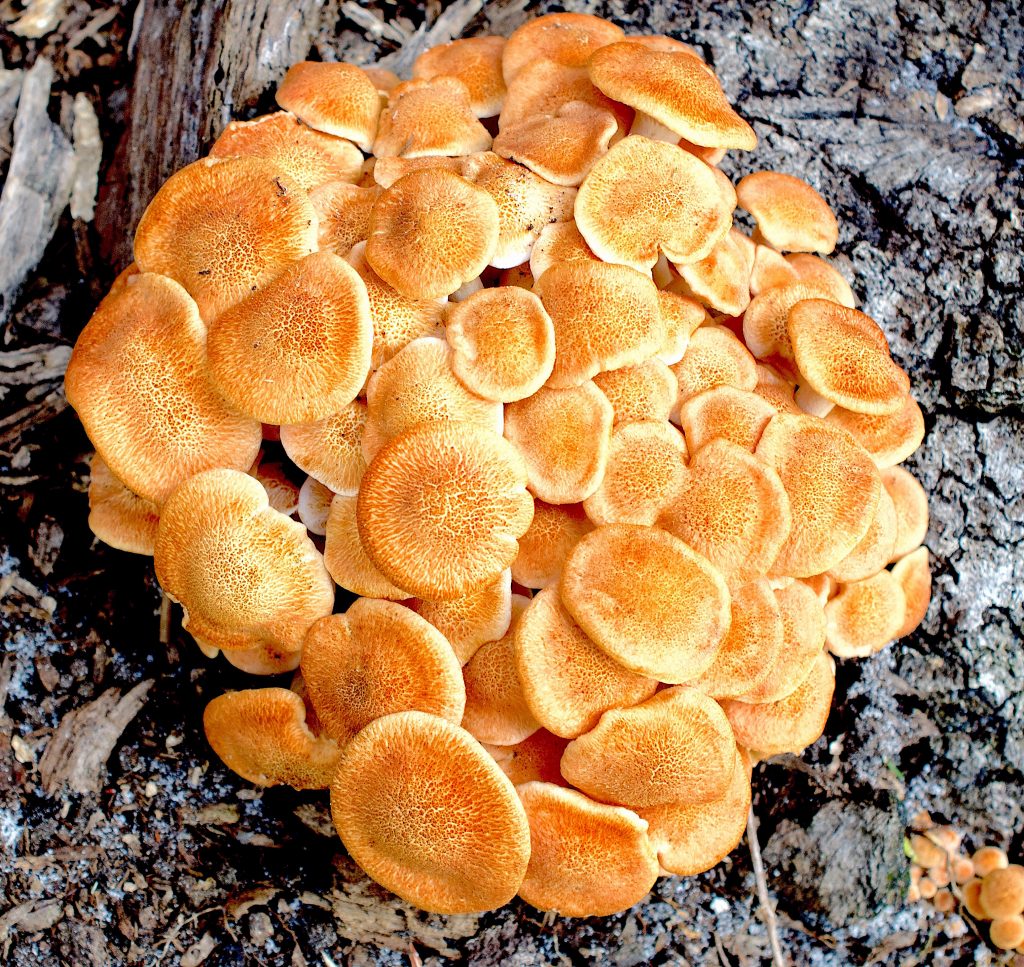
Ringless Honey Mushroom, Armillaria tabescens, Photo by Green Deane
It’s about time to make a prediction. Locally we had more than three inches of chilly rain over the weekend (and hurricane gusts, my neighbor’s mail box was blown away.) The ground temperature is still cool from winter. It is April. Those are a good combination for a spring flush of edible Ringless Honey Mushroom. They don’t do it every April but the conditions might be right this year. The ground is still too cold for chanterelles and fungal friends. Ground temperature and rain directly affect fungi production. Cool rain and cool ground in April equals Ringless Honey Mushrooms. Warm rain and warm ground in May/June equals Chanterelles.
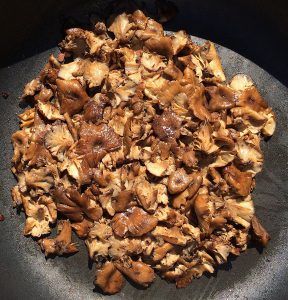
Ringless Honey Mushrooms have a good texture and taste. Photo by Green Deane
“Honeys” come with some conditions and warnings. Not all people can eat them. I know at least three folks for whom Honeys give severe gastro-intestinal distress, to put it mildly. This includes cooking them twice such as parboiling them first then frying. So the first time you try Honeys eat only a small amount. Next is method of preparation. Some people can’t eat them just fried, they have to parboil them first then fry them. I just fry them but much longer than store-bought button mushrooms. And parts…. most folks eat just young caps. They use the stems for flavoring. Honeys, in my opinion, is a good stewing mushroom. They holds its flavor and texture in a wet medium though frying the caps is my most common means of cooking them. Once they are cooked then I add other ingredients to the pan. I have a video abou them here and an article.
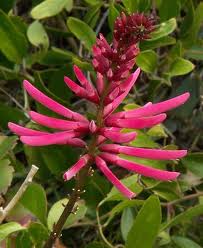
Eastern Coral Beans are easy to find this time of year. Photo by Green Deane
Also blossoming this time of year is the Eastern Coral Bean, sometimes called the Cherokee Bean. What is odd about this plant is the edible flowers produce toxic beans. So we do not eat the red and black beans. A few of the red blossoms are edible raw — with precautions — but they are usually boiled then mixed with other foods notably scrambled eggs. When you cook the blossoms they turn light green. The distinctive shape of the leaves makes the shrub easy to identify. Young leaves are edible cooked but are marginal fare. Like Pawpaws they prefer dry, sunny places. A few raw red blossoms seem okay but if eaten in larger amounts they can be mind altering and approaching dangerous. Boiled they are fine. (Juice from the shrub’s stems, by the way, has been used to treat scorpion stings and the toxic beans have a chemical that is close to the alkaoid curare which can cause breathing paralysis.) You can see my video about the species here or read more about the Eastern Coral Bean here.

Classes are held rain or shine or cold. (Hurricanes and storm fronts are an exception.) Photo by Kelly Fagan.
Spanning the state this weekend with foraging classes, Ocala to West Palm Beach. The class in Ocala is now rare because of interference by the city. They don’t like people walking through the park looking at plants.
Saturday, April 17th, Jervey Gantt Recreation Complex, 2390 SE 36th Ave., Ocala, FL. 9 a.m. to noon. There is no fee for this class. You can make a donation afterwards if you like. This is because the City of Ocala says I must meet all the requirements of a football team if I want to teach in the park. It is either hold a free class there or never teach in Ocala.
Sunday, April 18th, Dreher Park, 1200 Southern Blvd., West Palm Beach, 9 a.m. to noon.
Saturday, April 24th, Bayshore Park, Bayshore Drive. Port Charlotte. 9 a.m. to noon, meet at the parking loot at the intersection of Bayshore Dive and Ganyard Street.
Sunday, April 25th, Seminole Wekiva Trail, Sanlando Park, 401 West Highland St. Altamonte Springs, Florida 32714. 9 a.m. to noon, meet at the first parking lot on your right after entry.
Saturday, May 1st, Blanchard Park, 10501 Jay Blanchard Trail, Orlando, FL 32817. 9 a.m. to noon, meet at the pavilion next to the tennis courts.
Sunday, May 2nd, Red Bug Slough Preserve, 5200 Beneva Road, Sarasota, FL, 34233. 9 a.m. to noon. This class is on Sunday by request.
For more information, to sign up or prepay, go here.
Watercress/Wintercress grew in a ditch behind an apartment complex I lived in near Sanford, Florida, some 35 years ago. How did the Eurasian native Nasturtium officinale, get there? It came to North America with the Europeans, found a good home, and stayed. Alabama became the epicenter of cultivating it then later Central Florida. Sanford, by the way, is named for Henry Sanford one of Lincoln’s ambassadors. He is called “General Sanford” but the gentleman never served in the military. He got the title for donating a cannon to the Union effort. Sanford was, however, big on big farming and for a few decades made the city of Sanford the big place to go in Central Florida nor Orlando.
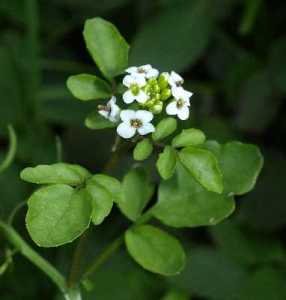
When President Calvin Coolidge came to Central Florida in 1929 it was to Sanford he went not little-ol’ backwater Orlando. The city of Sanford had everything: River, rails, road and Rollins college. But it lacked leadership giving Orlando a chance to make its mousey mark. Rollins moved to Winter Park. As Coolidge did so did watercress which is why it ended up in the ditch behind the apartment complex in Sanford. The entire area was truck farms and one of their winter crops was watercress. Peppery like nasturtiums it is edible raw or cooked but make sure you get it from wholesome water. Nasturtium by the way literally means “twisted nose.” Where I collect watercress to be eaten raw is about a half mile down stream from the Wekiva River boil (its main spring and headwater.) But there’s a lot of water hemlock around so I have to pick carefully. This time of year the river is mostly water hemlock. To read more about watercress go here. I have a video on watercress here. To read about the deadly Water Hemlock go here.
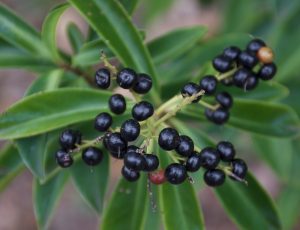
Marlberries aren’t too edible. Photo by Green Deane
Marlberries and I don’t meet too often, about once or twice a year and then usually while I’m conducting a class so I don’t have the time to get acquainted better. There is also a certain lack of motivation because even at its best marlberry is not a great trailside nibble. A complicating headache is there are several malberries of varying quality. They are also related to the invasive species Coral Berry, Ardisia crenata, which has been implicated in cattle poisoning. Reportedly found mid-Florida and south I have found Marlberries in Dreher Park in West Palm Beach, LaStrange Preserve in Ft. Pierce, and Emerson Point near Sarasota. Around the same time and in the same habitat you find Marlberries you can also see Rapanea punctata, Colicwood, one of those mystery pants one finds in wet woods this time of year. It looks like a drab cross between a mangrove and a beautyberry and used to be called Myrsine guianensis. Colicwood’s small yellow blossoms and black fruit grow directly on the branches, helping you identify it. There’s not a whole lot of literature on the species so the berries are probably not edible. As it is called “Colicwood” suggest some medicinal uses. To read more about the Marlberry and its strange relatives go here.

Green Deane videos are now available on a USB.
150-video USB would be a good spring present and is now $99. My nine-DVD set of 135 videos has been phased out. The USB videos are the same videos I have on You Tube. Some people like to have their own copy. The USB videos have to be copied to your computer to play. If you want to order the USB go to the DVD/USB order button on the top right of this page. That will take you to an order form. I’d like to thank all of you who ordered the DVD set over the years which required me to burn over 5,000 DVDs individually.

Green Deane Forum
Want to identify a plant? Perhaps you’re looking for a foraging reference? You might have a UFO, an Unidentified Flowering Object, you want identified. On the Green Deane Forum we — including Green Deane and others from around the world — chat about foraging all year. And it’s not just about warm-weather plants or just North American flora. Many nations share common weeds so there’s a lot to talk. There’s also more than weeds. The reference section has information for foraging around the world. There are also articles on food preservation, and forgotten skills from making bows to fermenting food.
Your donations to upgrade the EatTheWeeds website and fund a book were appreciated. A book manuscript has been turned it. It had 423 articles, 1315 plants and a third of a million words. What it will be when the publisher is done with it next year is unknown. Writing it took a significant chunk of time out of my life from which I have still not recovered. (Many things got put off.) The next phase is to update all the content on the website between now and publication date. Also note as it states above the 135-video DVD set has been phased out for 150-video USB. Times and formats change.
This is weekly newsletter #453 If you want to subscribe to this free newsletter you can find the sign-up form in the menu at the top of the page.
To donate to the Green Deane Newsletter click here.


How right you are re: honey mushrooms. I can eat them pickled but otherwise it certainly does a weeks worth of gastro-intestinal upset for me. I use Pat Conroy’s pickled shrimp recipe after boiling the mushrooms and they are delicious.
simply fantastic information. Thank you!